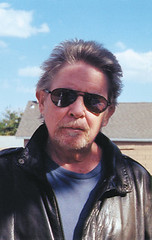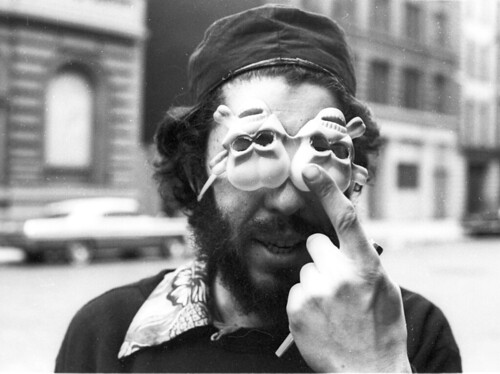 Ralph Ginsburg Coca Crystal
Ralph Ginsburg Coca CrystalThe first thing on Jackie Diamond’s to-do list: “2008 – Publish book.”
“You see I’m behind schedule,” the 64-year-old said of the unfinished work, her chest purring with laughter. “I got busy with cancer.”
Ms. Diamond is better known to students of the underground as Coca Crystal – a secretary, writer, and “Slum Goddess” for The East Village Other who went on to host a cult cable-access television show for nearly two decades.
In 2006, she was diagnosed with lung cancer. Since then, she’s had three operations to remove over a third of her lungs, undergone chemotherapy, and become a patient at Memorial Sloan-Kettering Cancer Center in Manhattan. The last time her cancer returned, her doctor told her it had spread to a part of her lung that was inoperable.
Her to-do list continues: “2010 – Movie based on my life released. Drew Barrymore stars as Coca Crystal.”
“And then the dignitaries and the party,” Ms. Crystal imagined. “And then I’ll live happily ever after. Finally.”
But the real reason she wants to publish her book isn’t the dream of a movie deal – it’s Gus. Read more…
 Nancy Naglin Joe Kane
Nancy Naglin Joe KaneA veteran of The New York Ace, High Times, The New York Daily News and many other publications, Joe Kane describes how he got his start at EVO.
When I first migrated to Manhattan from Queens in 1970, it was with dreams of becoming a working scribe, preferably writing Beat fiction (unfortunately, one of the few things I was born too late for) and/or covering film in some capacity. Instead, I landed a boring temp job typing at a downtown insurance firm. During this time, somewhat happier circumstances led me to Screw, where the magazine’s then-art directors, Larry Brill and Les Waldstein, were going halves with publisher Al Goldstein on a new spin-off tab titled Screw X, a satirical variation on Screw (the height of redundancy, no?)
I auditioned for a writing/editing gig, with no guarantee Larry and Les would even get back to me. But a couple of days later, the phone rang in my East Sixth Street pad with promising news from the pair: Seems my work had been extolled by another of their writers, Dean Latimer, who told them it was “almost as good” (accent on almost) as his own stuff and that they should hire me straightaway.
For me, this was a frankly stunning turn of events. It so happened that Dean, whom I had never met, was already something of a personal hero; his “Decomposition” column and other writings were my favorite sections of The East Village Other. I considered Dean one of the most vivid and versatile writers I’d ever read anywhere, one equally adept at reportage, “think pieces,” memoir, criticism and totally devastating satire. That he had encouraging words for my fledgling efforts cheered me no end, and I resolved to thank my benefactor for his unsolicited largesse. Read more…
 Kathy Streem Lynda Crawford, 1971
Kathy Streem Lynda Crawford, 1971Breathless — not just from the late-night climb up 11 flights to the EVO office on East 12th Street, or the astonishing art by the likes of Yossarian, Spain, Little Moon, Joe Schenkman, Brad Holland, R. Crumb, Kim Deitch, Trina Robbins, and Fred Mogubgub, or by Dean Latimer‘s gorgeous prose, or the thrill of reading Ray Schultz, or from the stunning reportage of Jackie Friedrich, Pat Morris, and Claudia Dreifus, or the amazing true life adventures of Coca Crystal (subduing a would-be attacker with a tune on her guitar) and Steve Kraus, or the Krassner interview by Kathy Streem, or the wondrous music reviews by Richard Meltzer and Charlie Frick (and Charlie’s magical layouts), or Tuli’s poetry and songs, Vincent Titus’ fables, Honest Bob Singer’s film writings, Rex Weiner’s off-off Broadway reviews (he was homeless and theaters were warm), Tim Leary’s communiqués from Algeria, A. J. Weberman‘s illuminating investigative portraits, or the vocal harmonies of Steve Heller, Latimer, and Schultz; but also from EVO’s coverage of the major events of the time: efforts to stop the Vietnam War, the Pentagon Papers, the Panther 21 trial, American Indian Movement protests, the murder of George Jackson, the Attica uprising, and Bob Dylan’s 30th birthday party, all produced at high intensity under editor Jaakov Kohn‘s benign leadership.
“EVO is not a tit!” I remember editor Allen Katzman telling several of us when salaries were slashed to the single digits, and then disappeared, during the post–salad days of the early 1970s — my tenure.
I waitressed to pay the rent on my $51-per-month apartment on East Sixth Street and to be able to eat a little more than the nightly fare of free chicken wings and chickpeas at Max’s Kansas City that many subsisted on. The EVO piece I wrote that is most remembered came out of that gig at a deli on Christopher Street when John and Yoko happened in one night and I interpreted their relationship through bits of conversation, body language, and by dissecting leftover pieces of blueberry blintz (A. J. gave me kudos for that one); it was reprinted in the Berkeley Barb and a bunch of other papers too. Read more…
 Bob Simmons Tuli Kupferberg
Bob Simmons Tuli KupferbergThe funniest part of reminiscing about the uber-subversive East Village Other for The New York Times is that the latter set me on the road to rebellion before the former was even founded in 1965. I’m told I was reading by age four and within a few years the first section I grabbed when the Sunday Times arrived every weekend was the Book Review. The Grove Press ads kidnapped my imagination: Who was this Alain Robbe-Grillet guy and how do you pronounce his name? Why was William Burroughs considered so dangerous and did his characters have meals while wearing no clothes? And speaking of clothes, how come the girls on Grove’s covers wore so little?
Obviously my nascent libido was ready for plucking, but my fascination was not simply sexual. I wanted to know why in the land of the First Amendment some had wanted to ban these books.
I bought my first issue of the Village Voice in February 1966; it contained an obituary of the abstract expressionist Hans Hofmann. Already a Dylan fan, I scanned the ads for folk clubs and was absolutely smitten by bohemia. The first girl who won my heart in elementary school was Jessica Hentoff (I don’t recall my feelings being reciprocated) and her father Nat wrote for the Voice. Soon I picked up the Voice’s competitor, The East Village Other.
No friends’ parents wrote for EVO. Scruffier, funnier and dirtier than the Voice, EVO was not simply about bohemia, it was an anarchist’s bomb in newsprint hurled at the bourgeoisie. Even at my tender age, I knew that I didn’t like the world that grown-ups had created. The troublemakers at The Other were expressing themselves in ways I could only daydream about at that point. Read more…
In Larry “Ratso” Sloman’s 1998 book, “Steal This Dream: Abbie Hoffman and the Counter-Culture Revolution in America,” he recounts what happened the day Abbie Hoffman dragged him and Peter Leggieri out of the East Village Other office to witness the Yippie icon’s attack on Wall Street. Mr. Sloman was a lowly EVO intern at the time who credits the paper with giving him his start as a writer. The excerpt is reprinted here with the author’s permission.
Read more…
 Fred W. McDarrah/Getty Images From left: Dan Rattiner, Walter Bowart, and brothers Allen and Don Katzman. Jan. 14, 1966.
Fred W. McDarrah/Getty Images From left: Dan Rattiner, Walter Bowart, and brothers Allen and Don Katzman. Jan. 14, 1966.Little is it known that Dan Rattiner, doyen of Dan’s Papers, helped launch the East Village Other alongside its more celebrated founders, the late Walter Bowart and the late Allen Katzman. In 1964, having abandoned graduate school in architecture at Harvard, Mr. Rattiner, in between gigs producing a summer newspaper in Montauk, rented an apartment in a brownstone on West 10th Street in Greenwich Village. A year later, in the fall of 1965, something amazed him on the newsstand at Eighth Street and Sixth Avenue. He picks up the story from there.
It cost 15 cents and was an enormous piece of newsprint all folded up into tabloid size. The four pages, when unfolded looked more like a work of modern art than a newspaper. A new way to print a newspaper was on the market. It involved using scissors and rubber cement to put together a proof of a page, then making a plate from a photograph of it and then printing from that. But I had never seen anyone make use of the new process like this before; most people just used it to mimic the old.
As for the content, it was also revolutionary. The lead headline read: “TO COMMEMORATE THE GLORIOUS NEWSPAPER STRIKE THE HERETOFORE UNDERGROUND ‘OTHER’ EXPANDS ITS PATAREALISM.” In huge black type, the words coiled along the perimeter of the page and ended with a half-tone photograph of a half-closed eye. “Peace Rally Breeds Strange Bedfellows,” was the headline below. “Generation of Draft Dodgers” read another headline below that.
I bought it. And I looked for, and found the name, address and phone number of the publisher and editor, Walter Bowart. Read more…









